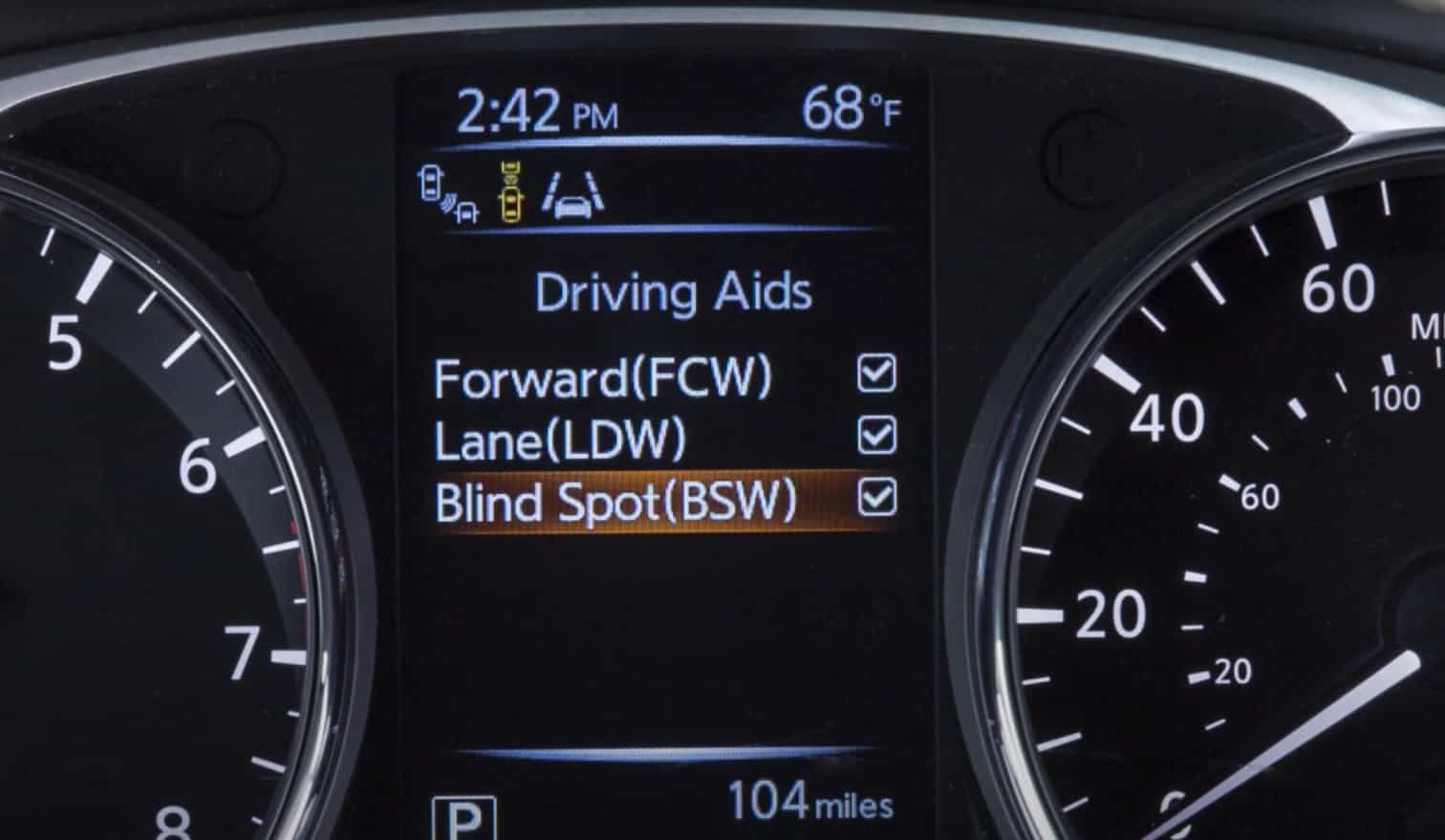You’re driving smoothly down the highway when suddenly, your Nissan Blind Spot Warning light doesn’t turn on. That small but vital safety feature you rely on every day just stopped working – and now, every lane change feels a bit riskier.
If your Nissan Blind Spot Warning is not working, don’t panic. This is a fairly common issue across several Nissan models, including the Rogue, Altima, and Murano. Most of the time, it’s not a major failure – just a small problem caused by dirt, weather, or a temporary system glitch.
In this guide, we’ll go through 7 easy fixes you can try today before heading to a dealership. From simple cleaning and system resets to checking your sensors and software updates, these quick steps can help restore your blind spot warning system in minutes.
Let’s get started and bring your Nissan’s safety system back to full strength.
Clean the Rear Bumper Sensors
One of the most common reasons your Nissan Blind Spot Warning is not working is because the sensors are dirty or blocked. The Blind Spot Warning (BSW) system relies on radar sensors located inside your rear bumper to detect nearby vehicles. When these sensors get covered by dirt, road salt, mud, or snow, they can’t send or receive signals properly – which makes the system temporarily stop working.
Start by parking your car in a well-lit area and visually inspecting the rear bumper. Look for any signs of dirt, water spots, or debris near the corners of the bumper where the sensors are installed. Use a soft microfiber cloth, warm water, and mild soap to clean the area. Avoid high-pressure sprays or harsh chemicals, as these can damage the sensor’s protective coating.
Once cleaned, restart your vehicle and test-drive it briefly. In most cases, your blind spot warning light will return to normal after a few minutes of driving. Keeping your sensors clean not only restores functionality but also prevents false alerts in the future.
Restart or Reset the Driver Assist System
If cleaning your sensors didn’t fix the issue, the next simple step is to restart or reset Nissan’s Driver Assist system. Sometimes, your vehicle’s onboard computer can experience a temporary glitch that causes the Blind Spot Warning feature to stop responding. A quick reset often clears these minor software bugs.
To do this, go to your vehicle’s Settings menu on the infotainment screen. Navigate to Driver Assistance → Blind Spot Warning, and toggle the feature off and on again. This forces the system to reinitialize. If that doesn’t work, turn off the ignition, wait about two to three minutes, and then restart the car. This brief power cycle allows all sensors and control modules to reboot properly.
In some cases, performing a soft reset of the Nissan Safety Shield 360 system can also help. This refreshes multiple safety features like Lane Departure Warning and Rear Cross Traffic Alert that work alongside the blind spot sensors. After restarting, take a short drive to let the system recalibrate. If the Nissan Blind Spot Warning resumes normal operation, the issue was likely just a temporary software freeze.
Check for Error Messages on the Dashboard
When your Nissan Blind Spot Warning is not working, your dashboard is often the first place to look for clues. The vehicle’s onboard computer automatically detects most system malfunctions and displays specific warning messages to help you understand the problem.
Common alerts include “Unavailable: Sensor Blocked”, “Blind Spot Warning System Fault”, or “Driver Assist Malfunction.” Each message points to a different cause – for instance, a blocked sensor usually means dirt or debris is interfering with the radar, while a system fault might indicate wiring or calibration issues.
When you see these messages, make sure to take a photo or note them down. This information will be extremely useful if you later need to visit a dealership or consult a technician. Some Nissan models also store fault codes that can be read using an OBD2 diagnostic scanner – this can help you pinpoint whether the issue is hardware-related or just a software glitch.
Checking and understanding dashboard warnings is one of the fastest ways to diagnose why your Nissan Blind Spot Warning stopped working, saving you both time and unnecessary repair costs.
Inspect for Recent Bumper Damage or Collision
If your Nissan Blind Spot Warning stopped working after a minor collision or bumper repair, there’s a good chance that the sensors have been misaligned. The Blind Spot Warning system depends on precisely calibrated radar sensors embedded inside the rear bumper. Even a small fender bender or careless parking scrape can shift their position just a few degrees – enough to make them unreliable or nonfunctional.
Start by closely examining your rear bumper for dents, scratches, or areas where paint looks freshly repaired. If your vehicle recently underwent bodywork, there’s a possibility that the sensors were reinstalled incorrectly or that the radar mounts were disturbed during the process. Misaligned sensors may cause false alerts, inconsistent warnings, or complete system failure.
If visual inspection reveals possible damage or misalignment, schedule a professional calibration at a certified Nissan service center. Technicians use special alignment targets and diagnostic tools to reset the sensor angles to factory specifications. Proper recalibration will restore your blind spot monitoring system and ensure it provides accurate detection again – a crucial step for maintaining safe driving.
Check Weather or Environmental Conditions
Sometimes, your Nissan Blind Spot Warning not working isn’t due to a malfunction at all – it’s just reacting to the environment. The radar sensors behind your rear bumper rely on clear airwaves to detect nearby vehicles. When conditions such as heavy rain, snow, fog, or ice block the sensors, the system may temporarily shut down to prevent false readings.
If you see a warning message like “Unavailable: Sensor Blocked”, don’t panic. This is a normal safety response. Moisture or dirt buildup can cause the radar signals to scatter, making detection unreliable. The best approach is to safely pull over, wipe away any water, snow, or mud from the rear bumper area, and then wait for the system to reset automatically.
You can also park the car indoors or in a warmer location to let any ice or condensation melt away. After a few minutes of driving, your Blind Spot Warning system should start working again. If the issue persists even in clear weather, that’s when you should check for deeper causes like misalignment or software faults.
Understanding how weather affects radar sensors helps prevent unnecessary trips to the dealership and keeps your Nissan’s safety system operating reliably all year round.
Verify Software Updates
If your Nissan Blind Spot Warning is not working consistently, outdated software might be the cause. Nissan regularly releases firmware updates that enhance the performance of the Safety Shield 360 system, including Blind Spot Warning, Lane Departure Warning, and Rear Cross Traffic Alert. These updates address known bugs, improve radar calibration, and optimize communication between the vehicle’s sensors and the onboard computer.
To check for available updates, go to your NissanConnect system settings or contact your local dealership. Some models can receive over-the-air (OTA) updates automatically, while others require manual installation during a service visit. If you’ve recently had your car repaired or replaced any safety-related components, a software refresh may also be necessary to sync all systems correctly.
After updating, restart the vehicle and take a short drive to allow the sensors to recalibrate. Many drivers have reported that their Blind Spot Warning system returned to normal after completing the latest software patch.
Keeping your Nissan’s software up to date not only fixes temporary issues but also ensures that all driver-assist features work together smoothly – maintaining both convenience and safety on the road.
Visit a Nissan Service Center for Calibration
If you’ve tried all the previous fixes and your Nissan Blind Spot Warning is still not working, the problem may be more serious and require professional attention. The system relies on highly sensitive radar sensors and precise calibration – even a small deviation in alignment or voltage can cause it to malfunction.
At a certified Nissan service center, technicians will use diagnostic tools to scan for error codes, inspect the wiring, and measure radar output accuracy. They can perform a sensor calibration procedure that resets the system to factory specifications, ensuring that the sensors are perfectly aligned with your vehicle’s geometry.
If any hardware components, such as radar modules or connectors, are damaged, they may need to be replaced. Repair costs can vary depending on the model and extent of the issue – typically between $150 and $500.
Professional calibration not only restores your Blind Spot Warning system but also guarantees the reliability of other advanced driver-assist features like Rear Cross Traffic Alert and Lane Departure Warning. It’s the best way to ensure your Nissan Safety Shield 360 operates exactly as intended, keeping you and your passengers safe on every drive.
Conclusion
If your Nissan Blind Spot Warning is not working, it doesn’t always mean an expensive repair is waiting for you. In most cases, simple fixes such as cleaning the sensors, resetting the system, or checking for weather interference can bring your safety feature back to life within minutes. Keeping your sensors clean, ensuring your software is up to date, and staying alert to dashboard warnings will go a long way in preventing future issues.
However, if you’ve tried all these 7 easy fixes and your Blind Spot Warning system still fails to activate, professional calibration at a Nissan service center is your safest option. Proper alignment and diagnostic testing ensure your vehicle’s Safety Shield 360 operates as designed – giving you the confidence to drive securely in all conditions.
Your Nissan’s blind spot monitoring is an essential part of your everyday driving safety. Don’t ignore it – take action early to maintain your car’s reliability and peace of mind.
Have you ever experienced your Nissan Blind Spot Warning not working? Which of these fixes worked best for you? Share your experience below!

